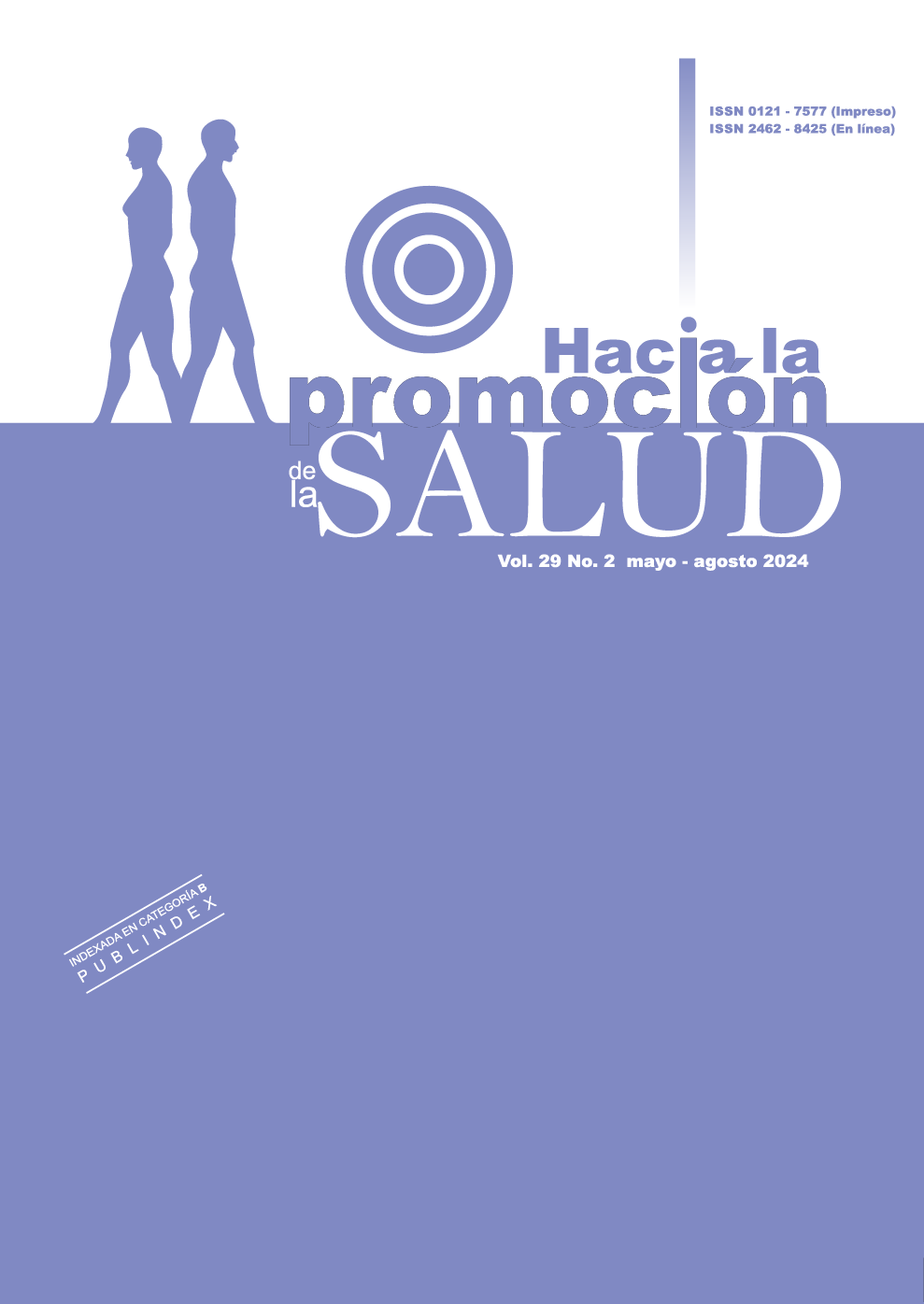Authors
Abstract
Risk perception is a concept that must become increasingly important in the planning of interventions that a Health and Safety professional must carry out in the workplace. Objective. To evaluate the perception of biological risk in nursing staff working at a hospital in the city of Armenia-Colombia. Methods. The study applied the Dimensional Evaluation of Risk Perceived in Workplace (DERP-W) to evaluate risk attributes, with a descriptive, quantitative, cross-sectional approach on a sample of 116 nurses and nursing assistants working at a hospital in the city of Armenia, Quindío. Results. When performing a mean analysis of each of the attributes, it was found that the majority of the sample perceives a high (33.6%) and medium high (29.3%) degree of knowledge of biological risk, as well as very high degree of fear of it (50.9% of those evaluated), and a very high degree of perception (30.2) to high degree of perception (23.3%) of being able to avoid a negative situation when exposed to biological risk. Conclusion. The workers of the hospital perceive that they have a good knowledge, while providing a perception of control of the circumstances surrounding biological risk, which could become overconfidence because many of the activities carried out at an institutional level are very frequent and can predispose to the mechanization of tasks and familiarity with risk, which are indispensable elements in managing unsafe actions that normally result in unwanted work events, such as work accidents.
References
República de Colombia. Ministerio de Trabajo. Decreto 1072 de 2015 [Internet]. [cited 2022 Oct 5]. Available from: https://n9.cl/cd394
República de Colombia. Resolucion 0312 de 2019.pdf [Internet]. [cited 2022 Oct 5]. Available from: https://n9.cl/c3n8w
Cruzet Fernández F. Las consecuencias derivadas de los accidentes biológicos y su prevención. Experiencia práctica del Hospital Clínico San Carlos de Madrid. Revista de Administración Sanitaria Siglo XXI [Internet]. 2004;2(4):633–52. Available from: https://n9.cl/hn0b2
Ribeiro WA, Souza CEA de L, Conceição VLD da, Evangelista D da S. Enfermeiro do trabalho na prevenção de riscos biológicos ocupacionais: uma revisão de literatura no âmbito hospitalar. RSD [Internet]. 2020 May 3 [cited 2024 Aug 21];9(7):e174973873–e174973873. Available from: https://rsdjournal.org/index.php/rsd/article/view/3873
Garcia LM. Riesgos Biologicos en los Trabajadores de la Salud, Una revision documental [Internet] [Monografía]. [Medellín, Colombia]: Universidad CES; 2020 [cited 2022 Jul 24]. Available from: https://repository.ces.edu.co/handle/10946/4908?show=full
Diaz T. AM. Conocimiento en riesgo biológico y prácticas de bioseguridad en el personal docente de la facultad de salud de una institución de educación superior de la ciudad de Cali [Internet] [Tesis de Maestría]. [Santiago de Cali, Colombia]: Universidad del Valle; 2013 [cited 2022 Jul 25]. Available from: https://bibliotecadigital.univalle.edu.co/bitstream/handle/10893/8406/CB-0494546.pdf;jsessionid=493FEEB7AF7553A2754ED0930B071E55?sequence=1
Tolentino AJ, Austria RD, Atienza KZ, Magdaraog MA, Jocom RT, Hapan MF. Knowledge, Attitudes, and Practices on Biosafety among Filipino Registered Medical Technologists: A Comparative Study. IJPRSE [Internet]. 2021 Aug 20 [cited 2024 Aug 21];2(8):300–9. Available from: https://journal.ijprse.com/index.php/ijprse/article/view/383
Halatoko WA, Sondou E, Sopoh GE, Kassegne A, Katawa G, Salou M, et al. Knowledge, attitudes and practices in biosafety and biosecurity in medical biology laboratories in Togo, 2021. Front Environ Health [Internet]. 2024 Apr 16 [cited 2024 Aug 21];3:1387476. Available from: https://www.frontiersin.org/journals/environmental-health/articles/10.3389/fenvh.2024.1387476/full
Ministerio de trabajo y Asuntos sociales, Instituto Nacional de Seguridad e Higiene en el trabajo. NTP 578: Evaluación Dimensional del Riesgo Percibido en el Trabajo (EDRP-T). [Internet]. 2001 [cited 2022 Sep 13]. Available from: https://www.insst.es/documents/94886/327064/ntp_578.pdf/545878eb-7e16-43fa-a4b6-b3dc18be7a14
Morales FJ, Sánchez-Tovar L, Hernandez-Runque E. La percepción del riesgo para la salud en trabajadores de una empresa agroquímica venezolana. Revista Cubana de Salud y Trabajo [Internet]. 2023 May 23 [cited 2024 Aug 21];24(2). Available from: https://revsaludtrabajo.sld.cu/index.php/revsyt/article/view/389
Rodriguez Sandoval ER, Perea Garcia PC. Eficacia de la programación neurolingüística para la mejora de la percepción del riesgo de los trabajadores de TRANSGRUPVILL S.R.L. Moquegua 2023. Repositorio Institucional - UTP [Internet].2024 [cited 2024 Aug 21]; Available from: http://repositorio.utp.edu.pe/handle/20.500.12867/8951
Pérez Penagos JJ, Regalado IA, Alvarado JMR. Percepción del riesgo biológico y condiciones de seguridad en auxiliares de enfermería de la Asociación de Comunidades Indígenas del Norte del Cauca (ACIN) 2015. Revista Colombiana de Salud Ocupacional [Internet]. 2016 [cited 2024 Aug 21];6(3):72–6. Available from: https://dialnet.unirioja.es/servlet/articulo?codigo=7890188
Slovic P. Perceptions of Risk: Reflections on the Psychometric Paradigm. 1990.
Robbins T, Douglas M, Wildavsky A. Risk and Culture: An Essay on the Selection of Technical and Environmental Dangers. Journal for the Scientific Study of Religion. 1983;
Beck Ulrich. La Sociedad del Riesgo. Vasa. 1998.
Icontect, CCS. GTC-45: Guidance For Hazard Identification And Occupational Health And Safety Risk Assessment. Bogotá; 2020 Jun p. 40.
IBM SPSS Statistics GradPack and Faculty Packs - SPSS Statistics GradPack y Faculty Packs [Internet]. 2021 [cited 2022 Oct 5]. Available from: https://www.ibm.com/co-es/products/spss-statistics-gradpack
Nimon KF, Oswald FL. Understanding the Results of Multiple Linear Regression. Organizational Research Methods [Internet]. 2013 Jul 25 [cited 2022 Oct 5]; Available from: https://journals.sagepub.com/doi/10.1177/1094428113493929
Weide AC, Beauducel A. Varimax Rotation Based on Gradient Projection Is a Feasible Alternative to SPSS. Front Psychol [Internet]. 2019 [cited 2022 Oct 5];0. Available from: https://www.frontiersin.org/articles/10.3389/fpsyg.2019.00645/full
Soler K, Torres A. Evaluación de percepción de riesgo aplicada a trabajadores de radioterapia. In Buenos Aires, Argentina: Sociedad Argentina de Radioprotección; 2015. p. 1–10. Available from: http://www.irpabuenosaires2015.org/Archivos/tr-completos/irpa/fullpapertemplate_IRPA20153209451.pdf
Soria MS, Martínez IMM, Prieto LL. La relación entre el exceso de confianza y los accidentes laborales en trabajadores de la construcción: un estudio cualitativo. Gestión práctica de riesgos laborales: Integración y desarrollo de la gestión de la prevención [Internet]. 2011 [cited 2022 Oct 25];(86):8–13. Available from: https://dialnet.unirioja.es/servlet/articulo?codigo=3750415
González YL. Evaluación de la percepción del riesgo ocupacional en trabajadores de una empresa del sector de la construcción en Bogotá D.C. nova [Internet]. 2015 Jun 15 [cited 2022 Oct 13];13(23):93. Available from: http://hemeroteca.unad.edu.co/index.php/nova/article/view/1709
Fajardo Zapata Á, Hernández Niño JF, González Valencia YL, Hernández HA, Torres Pérez ML. Percepción del riesgo mediante sus atributos psicosociales en trabajadores de la industria metalmecánica en la ciudad de Bogotá, D.C (Colombia). Nova. 2019;
Alrawad M, Lufi A, Alyatama E, Elshaer I, Amin Almaiah M. Percepción de Riesgos y Peligros Ocupacionales y Ambientales entre los Trabajadores Mineros: Un Enfoque de Paradigma Psicométrico. International Journal of Environmental Research and Public Health. 2022;1–12.
Velázquez Narváez Y, Medellín Medellín Moreno J. La percepcion de riesgos como factor causal de accidentes laborales. Gestión práctica de riesgos laborales: Integración y desarrollo de la gestión de la prevención. 2012;
Rivera JG. Comunicación del Riesgo: Hacia un modelo efectivo y situacional. Instituto Tecnológico Metropolitano; 2013. 651 p.
Armas I, Avram E. Patrones y tendencias en la percepción del riesgo sísmico. Estudio de caso: Municipio de Bucarest/Rumania. Peligros Naturales. 2008;147–61.


 PDF
PDF
 FLIP
FLIP



























